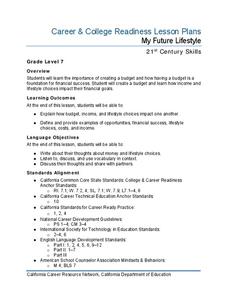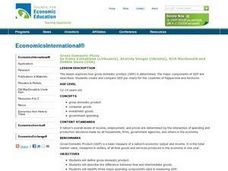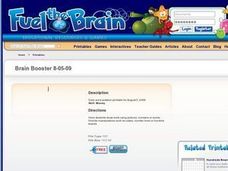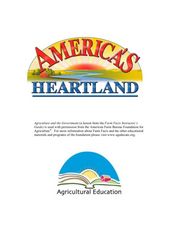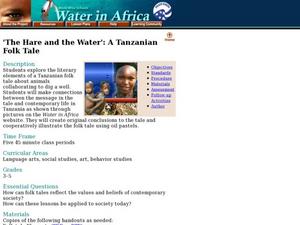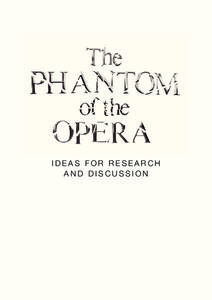Curated OER
Spend, Save, Invest or Donate (9-12)
Students explore the concept of personal finance. In this philanthropy instructional activity, students examine decisions they make about money as they discover the definitions of philanthropy, resources, scarcity, choice, benefits,...
California Department of Education
My Future Lifestyle
Mortgage, insurance, car payments...how much money will your learners need to support their desired lifestyle? Part three in a six-part college and career readiness lesson plan series tasks young job seekers with creating a monthly...
Curated OER
Gross Domestic Pizza
Students explore major components of gross domestic product (GDP) and how it is determined; students create and compare GDP pie charts for the countries of Pepperonia and Anchovia.
Curated OER
Going Shopping
Students investigate the value of money. In this money lesson plan, students simulate going shopping in their classrooms for various objects. Students use play money to pay for the objects.
Fuel the Brain
How Much Did They Spend?
Young learners do basic addition (with numbers between 50 and 323), to solve two short word problems. This is a great activity to start the day, or consider using this as a type of summative assessment.
Curated OER
Star Light, Star Bright
Four modules are a part of this stellar lesson plan. Space scientists view the electromagnetic spectrum, they generate waves on a computer screen in order to measure frequency and wavelength, discover how light is related to temperature,...
Curated OER
The Learning Network: Re-envisioning Classic Stories
Readers reflect on enjoyable stories they know, brainstorm criteria that make a story "good," analyze a New York Times article about innovative children's performances, re-envision classics on their own, and peer edit drafts. Use this as...
Curated OER
Buying New Stuff
Young spenders take a look at the best ways to save and spend money. This type of financial education is lacking in schools, so implementing this instructional activity would be of great value to your students. Things like bank checking...
Curated OER
Get in the Newspaper Habit
Dive into journalism with your high schoolers! The resources provided here will help your learners write unbiased, clear, and succinct newspaper articles. First they spend time sifting through stacks of articles, filling out a graphic...
Curated OER
Agriculture and the Government
Students study the government's involvement in the U.S. A's food production and make connections relating to farm programs. For this historical agriculture lesson, students read content and research significant information....
Curated OER
Languages in Contact, Socio-spatial Diversity: Language Varieties
Spend some time considering the functions and types of language such as vernacular, standard, and pidgin. This lengthy presentation would benefit a college-level linguistics course with its accurate descriptions and plenty of examples....
Curated OER
The Hare and the Water: A Tanzanian Folk Tale
"The Hare and the Water," a Tanzanian folk tale, lends a global perspective to literary analysis. Learners spend the first two days reading and storyboarding. On day three, they examine folk tale elements (worksheet included), and design...
Curated OER
Familiar Commands
Familiar commands are probably used more frequently than formal commands, so make sure you spend an adequate time covering them. This worksheet provides great explanation, a clear chart, and a practice opportunity. It's a great way to...
Virginia Department of Education
Researching Information
Give your junior high researchers a clear concept of how to go about starting their research paper with the resources available in this exercise. Learners develop an idea to research, and spend time in the library or computer lab...
Carl's Corner
Rhyme Time
When its time to rhyme you won't have to spend a dime on this free packet of 57 rhyming worksheets. There's very little waste as kids cut and paste words found at the bottom of the page. How sage.
Phantom of Opera
The Phantom of the Opera: Ideas for Research and Discussion
You could spend a full day discussing The Phantom of the Opera and not scratch the surface, but a set of lessons about the literary elements and themes of the musical production is a great start. Young thespians build upon the...
Consortium for Ocean Science Exploration and Engagement (COSEE)
Arctic Smorgasbord
Though the walrus spends roughly one third of its time on land, it eats organisms that live on the bottom of the ocean. The first in a series of five, the lesson uses a variety of plant and animal cards to have scholars build an arctic...
Curated OER
Cartoons for the Classroom: The Economic Paradox
It's a classic conundrum of economics: voters want jobs, but don't want to spend the money required for businesses to hire. This political cartoon analysis worksheet has students analyzing this enigma and responding to 3 talking points...
Curated OER
Cartoons for the Classroom: Unemployment
It's the classic paradox in this political cartoon analysis; any jobs plan requires extra government spending. However, the unemployed aren't willing to concede to more federal spending for what they want most, jobs. Background...
Council for Economic Education
Opportunity Cost
The price of those new shoes involves more than just money! Individuals explore the concept of opportunity cost using a video clip and gratification discussions. They prepare a budget based off of their set of values in regards to...
Curated OER
Writing Bug: Creative Writing
Do your writers have the writing bug? Give them this short prompt as today's writing activity. They have to decide how they'd spend $100,000, but they can't spend it on themselves! There's also a rectangular box at the bottom of the...
Curated OER
Introduction to the National Debt
Students relate the national debt to the economy. In this algebra instructional activity, students discuss what the national debt is, create a national budget based on priority and what the government should spend money on. They analyze...
Federal Reserve Bank
Cotton in My Sack
As part of a study of saving choices and opportunity costs, class members listen to a reading of Lois Lenski's Cotton in My Sack, and then evaluate the spending choices made by the Hutley family.
Illustrative Mathematics
Planes and Wheat
Understanding government spending is difficult. The number of variables can be enormous. In the corresponding resource, number crunchers are given one equation related to government spending with a number of variables. Your class is...
Other popular searches
- Spending Money
- Government Spending
- Budgets and Spending
- Spending and Saving Money
- Deficit Spending
- Consumer Spending
- Spending a Million Dollars
- Math Spending Money
- Spending Money Worksheet
- Spending Money Wisely
- Personal Spending
- Saving Spending Money

